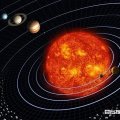模拟: 盘状星系的形成
Simulation: A Disk Galaxy Forms
Video Credit: TNG Collaboration, MPCDF, FAS Harvard U.; Music: World’s Sunrise (YouTube: Jimena Contreras)
Explanation: How did we get here? We know that we live on a planet orbiting a star orbiting a galaxy, but how did all of this form? Since our universe moves too slowly to watch, faster-moving computer simulations are created to help find out. Specifically, this featured video from the IllustrisTNG collaboration tracks gas from the early universe (redshift 12) until today (redshift 0). As the simulation begins, ambient gas falls into and accumulates in a region of relatively high gravity. After a few billion years, a well-defined center materializes from a strange and fascinating cosmic dance. Gas blobs — some representing small satellite galaxies — continue to fall into and become absorbed by the rotating galaxy as the present epoch is reached and the video ends. For the Milky Way Galaxy, however, big mergers may not be over — recent evidence indicates that our large spiral disk Galaxy will collide and coalesce with the slightly larger Andromeda spiral disk galaxy in the next few billion years.
Open Science: Browse 3,000+ codes in the Astrophysics Source Code Library
Tomorrow’s picture: recycling a star
模拟: 盘状星系的形成
影片提供: TNG Collaboration, MPCDF, FAS Harvard U.; Music: World’s Sunrise (YouTube: Jimena Contreras)
说明: 我们从何而来的?我们生活在一个绕行恒星、然后再一同绕星系运行的行星上,但这一切到底是如何形成的?由于我们宇宙的变动过于缓慢而难以追踪,只能借助于快速的电脑模拟来找出答案。具体来说,这部来自IllustrisTNG合作团队的主题影片,追踪了气体从早期宇宙(红移12)到如今(红移0)如何移动。在模拟启始之时,周边的气体坠入并聚集在重力相对高的区域里。数十亿年之后,一个明确的核心从一场奇幻而迷人的宇宙之舞中形成出来。气团里的部分斑点为小型伴星系,它们在我们这个年代降临、影片结束时,掉入旋转的星系里并被吸收。然而对银河系来说,大型合并可能还没结束,因为最近的证据显示,我们的大螺旋盘状星系将在接下来的数十亿年内,与更大的仙女螺旋盘状星系互撞并合并。
开放科学: 浏览天体物理学源代码库中的3,000多个代码
明日的图片: recycling a star


